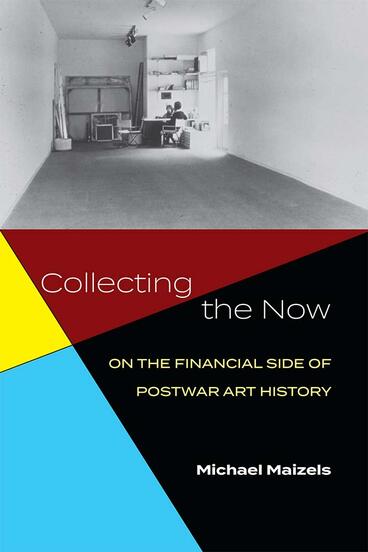Collecting the Now
On the Financial Side of Postwar Art History
How dealers and artists made pop art fine
Description
Collecting the Now offers a new, in-depth look at the economic forces and institutional actors that have shaped the outlines of postwar art history, with a particular focus on American art, 1960–1990. Working through four case studies, Michael Maizels illuminates how a set of dealers and patrons conditioned the iconic developments of this period: the profusions of pop art, the quixotic impossibility of land art, the dissemination of new media, and the speculation-fueled neo-expressionist painting of the 1980s.
This book addresses a question of pivotal importance to a swath of art history that has already received substantial scholarly investigation. We now have a clear, nuanced understanding of why certain evolutions took place: why pop artists exploded the delimited parameters of aesthetic modernism, why land artists further strove against the object form itself, and why artists returned to (neo-)traditional painting in the 1980s. But remarkably elided by extant scholarship has been the question of how. How did conditions coalesce around pop so that its artists entered into museum collections, and scholarly analyses, at pace unprecedented in the prior history of art? How, when seeking to transcend the delimited gallery object, were land artists able to create monumental (and by extension, monumentally expensive), interventions in the extreme wilds of the Western deserts? And how did the esoteric objects of media art come eventually to scholarly attention in the sustained absence of academic interest or a private market? The answers to these questions lie in an exploration of the financial conditions and funding mechanisms through which these works were created, advertised, distributed, and preserved.
Michael Maizels is an Affiliate with metaLAB@Harvard.
Reviews
“Collecting the Now is a piercing must-read account of the foundations of the contemporary art market. Maizels’ thoroughly researched yet accessible book offers a wealth of fresh insights, revealing some of the deft business practices fueling the industry’s recent ascent and offering some much-needed historical perspective on what this all means.”
—Noah Horowitz, Worldwide Head of Gallery & Private Dealer Services, Sotheby’s, and author of Art of the Deal: Contemporary Art in a Global Financial Marketplace
- Noah Horowitz
“Maizels has occupied the gap between patronage studies, associated with an earlier art-historical paradigm, and contemporary art market studies to demonstrate the symbiotic relationship between financial innovation and aesthetic reputation.”
—David Joselit, Professor of Art, Film, and Visual Studies, Harvard University
- David Joselit
“Having been there, I think Maizels’ insights and anecdotes are right on target. A great read for those of us who were there and those of you who were in diapers.”
- Asher Edelman
—Asher Edelman, International Collector and Financier
“Collecting the Now strikes many chords. This is a standard-setting resource in today’s art market, providing the most original, scholarly and insightful analyses of this highly complex environment. Having worked with many of the people profiled in the book, such as Virginia Dwan and Michael Heizer—whose radical work, Double Negative, came to The Museum of Contemporary Art, Los Angeles (MOCA) under my leadership—I also find the book a welcome reminder of the great artists, curators, and collectors whose creativity and dedication made many of our most important cultural events and institutions possible. Kudos to Mr. Maizels.”
- Richard Koshalek
—Richard Koshalek, Director, The Museum of Contemporary Art, Los Angeles, 1979-2000; Director, Hirshhorn Museum and Sculpture Garden, Smithsonian Institution, 2009-2013
“Maizels takes us on a fast-paced journey through the rise of contemporary art—offering counterintuitive insights, dispelling myths, and revealing the economic principles of a market that is ultimately more rational than it appears.”
- Evan Beard
—Evan Beard, EVP at Masterworks and former Managing Director of Art Services at Bank of America
“Collecting the Now is the rare book that, because Maizels uses case studies, is able to provide the reader with both compelling details as well the big picture of how the worlds of money and art are intertwined in innovation in surprising ways.”
- Mukti Khaire
—Mukti Khaire, Girish and Jaidev Reddy Professor of Practice, Cornell Tech and Cornell SC Johnson College of Business
“Collecting the Now delivers an exciting behind-the-scenes view of art since the 1960s, unmasking the financial mechanisms that determine what art gets exhibited, written about, and, finally, lionized by art history.”
- Joshua Shannon
—Joshua Shannon, Professor of Contemporary Art History and Theory, University of Maryland

